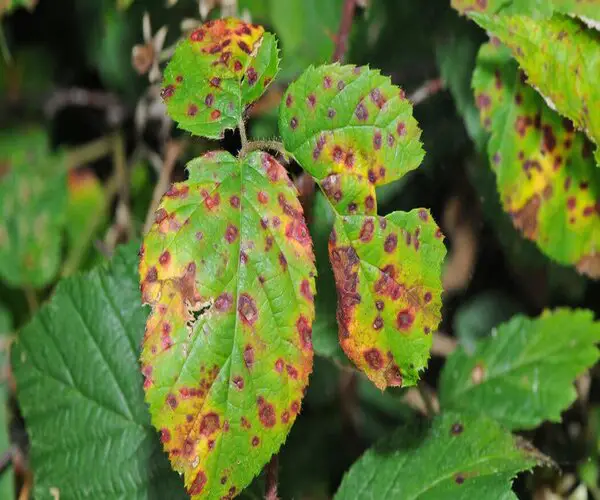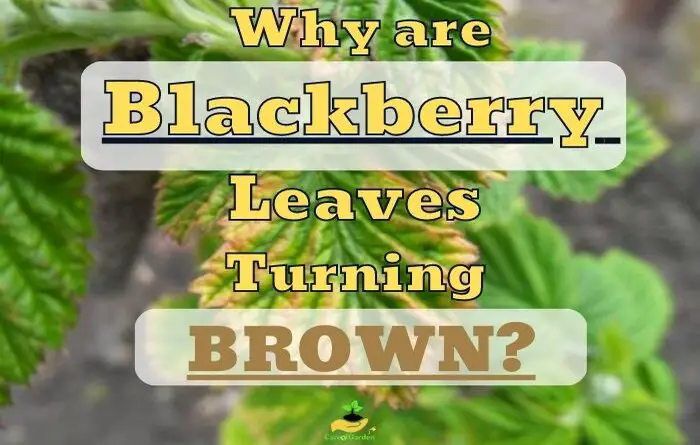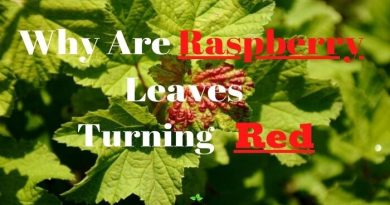Why Are Blackberry Leaves Turning Brown? Find Out Now!
When blackberry leaves are turning brown, identifying the cause is not always simple: it could be suffering from one or more of the numerous diseases that affect the foliage or by other agricultural mistakes.
Various causes, such as diseases, overwatering, excessive heat, humidity or pests are some of the reasons that can cause the blackberry leaves to turn brown.
| Causes Blackberry Leaves Turn Brown |
|---|
| 1. Too Much Watering |
| 2. Heat Stress |
| 3. Biological and Chemical Stress |
| 4. Lack of Light |
| 5. Over-fertilizing |
| 6. Pests |
| 7. Fungal Infection |
Gardeners are seeking a remedy regardless of the cause. Maybe even more crucial is figuring out how to salvage the fruitful crop of delicious berries. Here are some tried and true recommendations.
1. Too Much Watering
Overwatering or soil water buildup due to insufficient drainage is causing blackberry leaves to turn brown. In this way, it must be taken into account that most plants, whether they are in the ground, outside or in a pot, must have proper drainage to avoid excess water.
Most blackberries lie in the ground for two to three years before harvesting. During this period, the roots require space to expand and grow and ample moisture to thrive. However, excessive moisture can cause root rot and the death of established roots.
In damp conditions, root rot will manifest as a reduction in leaf size and browning of leaves at the branch tips. Eventually, the roots will decay, and the berries will begin to fall off the plant.
Treatment
Water the blackberries in the early morning. This allows plants to dry throughout the day and reduces the likelihood of leaf damage from excessive dampness.
If the damp soil cannot be dried by a period of dry or cold weather or by adding extra mulch, it may be essential to dig out and replant your plants, which a local horticulturist may also suggest.
2. Heat Stress
As a result of the heat stress, some plants will cease putting out new leaves and fruit. When under drought stress, blackberry leaves dry out and lose water, turning brown and brittle in the process. Insufficient water also hinders a plant’s ability to absorb essential nutrients, which can result in browning of the leaves.
This is a typical summer occurrence south of the Mason-Dixon line, where temperatures and humidity levels soar. Roots can get burned if they are out in the sun too long during the warmest portion of the day.
Blackberry plants thrive in a wide range of temperatures and humidity levels. However, root rot and poor development may occur in thick clay soils, particularly after heavy rainfall. Too much shadow prevents blackberries from reaching full maturity, leading to less harvests.
Treatment
To ensure that your blackberries receive an even amount of sunlight throughout the growing season, rotate them every two months. Plants need to be moved into the shade on hot days.
Mulch may be used to shield plants from the sun and prevent water from evaporating too quickly in gardens. A light blanket can be used to cover blackberry bushes in the absence of a substantial mulching system.
Blackberries will do better in hotter climates if planted in soil that drains well and has good airflow. The fruits will be lower in size, but their sweetness and taste should compensate for it.
Only put your blackberry plants in spots with plenty of room to expand and provide a bumper crop over time. Do some investigating to find out where your plants will thrive the most.
3. Biological and Chemical Stress
Some pesticides have the potential to poison plants to the point where they eventually die. Chemicals such as organophosphates and chlorinated hydrocarbons are examples of manufactured chemicals. Fertilizers high in potassium can also cause blackberry damage as browning, and softening the leaves.
Treatment
If you want to use a commercial chemical to treat your garden or plants, read the label first. Before spraying your garden with anything, ensure all infected or unhealthy plants have been removed.
Reduce fertilizer use by a third to half and sub in compost or tea instead. Compost and other organic fertilizers are great for the soil and may greatly benefit plant development.
4. Lack of Light
The optimal growth conditions for blackberry plants are six or more daily sunshine. Move your plants to a cooler, shadier spot if you reside in a hotter region. Heat stress therapy in the summer will be more effective with this.
Treatment
Blackberry bushes need to be planted in an area where they will receive at least six hours of indirect sunlight daily. Get some information on the weather where you live so you can plant your blackberries in the best possible spot.
5. Over-fertilizing
The leaves of a blackberry shrub will turn brown if you over-fertilize it. Fertilization of newly planted bushes is possible four to six weeks after planting. When fertilizing young plants, a slow-release formula works best.
| Over-fertilizing blackberry with | Blackberry Symptoms | Treatment measures |
|---|---|---|
| 1. Nitrogen | Brown spots form on blackberry leaves, they curl up and fall off. | Several small doses of fertilizer during times of need (reduction of leaching). Increase or maintain the organic matter of the soil in the long term |
| 2. Copper | The leaves turn yellow or brown, fall prematurely and the yield decreases. | Add copper sulfate to the soil. |
| 3. Manganese | Brown, white or yellow spots appear on the leaves. The leaves are twisted or wrinkled. | Soil fertilization with fertilizers containing Mn as a secondary component (thomaphosphate, slag lime, manganese superphosphate, etc.) |
| 4. Phosphorus | The leaves brighten sharply, and turn brown at the edges, later necrosis appears on them. | Apply phosphorus fertilizer close to plant roots (because of low mobility in the soil). Bring the pH to 6.0-6.5 (acidic or alkaline fertilizers) |
| 5. Boron | Burns appear on the edges of the leaves, after which the leaves curl and fall off. | Single and complex fertilizer with borax content (8kg borax = 1kg boron). |
| 6. Magnesium | The leaves darken and wrinkle. | Use fertilizers containing magnesium. |
Treatment
Starting from the second year, apply fertilizer twice a year, once in the spring and once in the middle of summer, to the blackberry bushes.
I recommend that you use a fertilizer with (10-10-10) a nitrogen content of 10%, phosphate content of 10%, and potash content of 10%. Each spring is a good time to apply compost or composted manure to the soil.
6. Pests
Pests are another common cause why blackberry leaves are turning brown. In addition, they can spread diseases from one plant to another.
Brown leaves can be caused by a number of the most common pests, including:
Red spider mite
The tiny fruit tree spider mite (Tetranychus urticae) draws attention to itself with its damage: Young blackberry leaves in particular are finely mottled with light yellow to brown colors, initially along the leaf veins, later on the entire leaf.
The leaves curl up and fall off in dry weather, the shoots grow stunted. Unlike other spider mites, fruit tree spider mites do not form webs. The best control method is to encourage beneficial predatory mites, lacewings and ladybirds .
Aphids
The blackberry aphid, which is dark green in spring and pale yellow in summer, feeds on blackberries. The pests hibernate as eggs and form several generations over the course of the year, which suck on the undersides of the leaves, causing the blackberry leaves to turn yellow, then brown and the tips of the shoots to grow stunted.
Natural enemies such as spiders, hoverfly larvae or birds can be used to combat aphids. It is also advisable to spray the plant with a nettle decoction – you can even make it yourself.
Under no circumstances should you resort to chemical agents in the event of an infestation with aphids, these also attack natural enemies.
Treatment
In order to combat pests, it is crucial to recognize the specific type of pests.
This may involve the use of pesticides or pest-specific remedies, the removal and destruction of infected leaves, or the use of pest-controlling natural predators.
Working with pests that infected blackberry leaves requires the use of rubber gloves.
If you plan on picking your berries, you may also use a commercial pesticide. Common in soil, fungi may be readily eradicated with any one of the many all-natural sprays.
7. Fungal Infection
Blackberry health can deteriorate if fungi land on it. Eventually, the fungus will damage the plant’s roots and cause the plant to die. As the blackberry leaves die, they will be turning brown and eventually fall off.
Treatment
Although fungi are essential to ecology, they can cause plant illness if they get access through cut stems or leaves. Compost tea and organic fungicide are two examples of natural treatments. Utilizing compost tea eliminates the requirement for fungicide spray.
You can avoid this by maintaining adequate airflow between rows. Species and cultivars with erect stems are less susceptible. If you have found the symptoms, try fungicides like lime sulfur during the dormant season to control rust.
Blackberry Leaf Rust

Blackberry Leaf Rust (Phragmidium violaceum) makes it’s appearance in the early spring when yellow-brown dots appear on the blackberry leaves transforming into pads with spores.
It has five stages of development, but it all begins at the end of spring, when tiny dusty brownish-yellow spots appear on the leaves and stems, which turn into large spots as they develop.
In mid-summer, with the development of the disease, orange-brown pads are already clearly visible on the upper side of the blackberry leaves. With a strong infection, the leaves begin to detach, and the shoots wither.
This is a fungus that overwinters on diseased leaves and attacks fresh leaves in March and April when the weather is warm and humid. If the infestation is severe, they will turn red and fall off.
Although rust spreads quickly in high humidity conditions, it can also affect blackberry bushes weakened from lack of water.
Treatment
As a preventive measure, remove all affected leaves in autumn. In spring it is enough to remove the freshly affected leaves before masses of spores form.
Blackberry rust is one of the more harmless diseases, because the harvest is only at risk if the infestation is severe. Therefore, do not immediately resort to chemical pesticides, but try these methods first:
- Remove infested leaves from the bush or collect them from the ground
- Never throw it in the compost
- Spores survive there and cause re-infection the next year
- Dispose of infected foliage in household waste or by incineration
Chemical control is only advisable if the blackberries were heavily infested in the previous year.
Spray as soon as the first leaf buds open in spring and repeat the treatment regularly according to the manufacturer’s leaflet. Diseases such as rust love moist air and can therefore be prevented by regular pruning – dry leaves reduce infestation.
Bacterial Leaf Spot

Brown spots appear on blackberry leaves affected by bacterial leaf spots (genus Sphaerulina rubi), and the remainder of the leaf may become yellow and drop.
The disease begins on the leaves, turning them brown and spreads to the rest of the blackberry. Blackberry bushes can lose their leaves to infection and die within a few weeks.
Bacterial Leaf Spot first manifests itself on previous year’s shoots towards the very end of spring or in the early summer.
They are most easily seen on the leaves, where they appear as tiny, light brown dots with a diameter of up to 2.5 mm that progressively turn white with a black border.
Around the buds and internodes of the shoots, tiny, light brown patches start to emerge. Throughout the summer, the illness spreads rapidly, and by August, tiny black dots, the fungus’s fruiting bodies—had covered the leaves and stems.
The disease causes a delay in growth and shoot production as well as a slowing in the flow of nutrients through the tissues of shoots and leaves. The harvest for this year and the following year suffers as a result. The fruit are rotted, never mature, and eventually die.
Treatment
The most significant way to fight the disease is to remove and burn the afflicted shoots and leaves as soon as possible. Make sure to regulate blackberry feeding properly because overfertilization with nitrogen fertilizers might promote the growth of the disease.
The main method of treatment is a two-stage treatment of planting and soil with chemical preparations with a high copper content.
With a strong infection of the blackberry, it is recommended to rejuvenate the planting and replace the soil, since the spores of the fungus can stay on the site for a long time.
Before bud break, it is necessary to carry out preventive spraying of blackberry bushes with a 1% solution of Bordeaux mixture.
Several antibacterial fungicides, such as potassium bicarbonate, can be applied to the soil surrounding blackberry bushes to eliminate the bacteria. Or use a fertilizer with slow-release nitrogen.
The fungus thrives in low-pH, very acidic soils (below 6.5). Raising the soil pH with lime to a level over 6.5 improves disease resistance and reduces the likelihood of defoliation.
Conclusion
As you can see, it is important to know the exact causes why blackberry leaves are turning brown and be able to treat this issues. And, even better, to carry out their prevention.
If you follow this advices and carefully apply them to your blackberries, then problems will be minimized or hopefully disappear.




